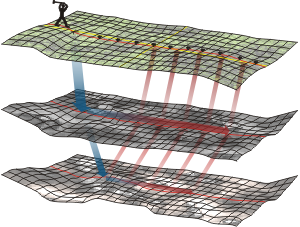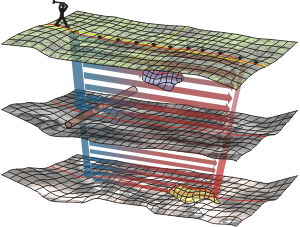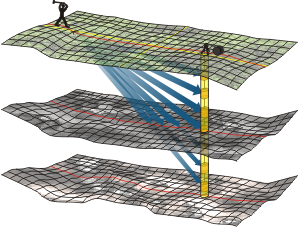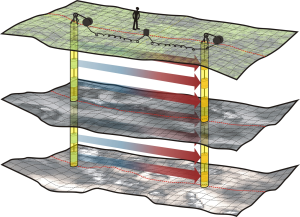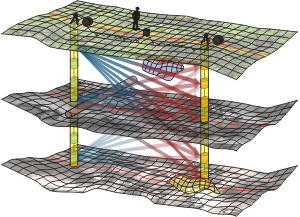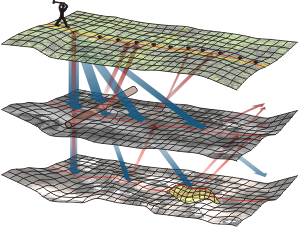Main Page | Knowledge base | Geophysics | Seismic studies
SEISMIC STUDIES
The seismic method is based on measurement and analysis of artificially generated seismic waves in the ground. These waves are elastic and transfer vibrations through the medium. Any change in the structure and its characteristics (eg, fractures, weathering, faults, a change in density and elastic modules & Poisson’s ratio) cause the changes of seismic waves parameters. During seismic studies, many types of waves are generated. Some of them can be used to evaluate the medium’s properties.
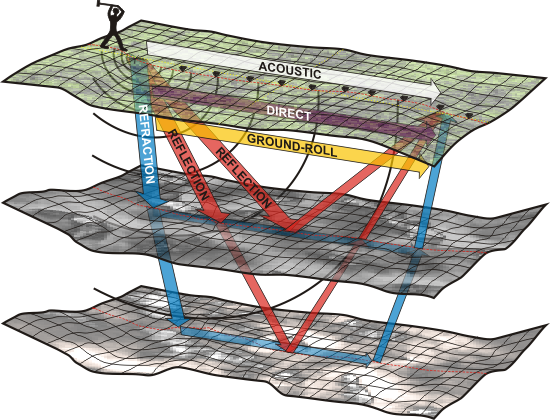
During measurements seismic vibrations are produced by energy sources such as sledgehammer, weight drop, sparker, explosives, Vibroseis, airgun, buffalo gun, boomer. Receivers (geophones, accelerometers or hydrophones) are used to record ground vibrations. For engineering tasks several tens of receivers located along the seismic profile are used. The geometry of the measurement depends on the purpose of studies, measurement technique, terrain conditions, expected depth and accuracy.
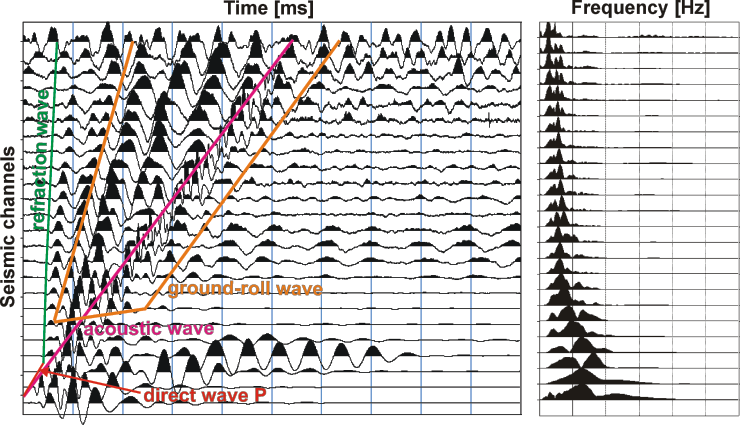
The field data are transferred to a modern seismic recorder and after A/D conversion stored on mobile tougbook. The next step is data processing using seismic sophisticated software, depending on the measurement technique. The final step is seismic or geological engineering interpretation (velocity curves, depth profiles, cross-sections, maps) and presented as documentations, reports etc.
The most commonly used seismic measuring techniques are:
Seismic refraction technique
bases on the measurement of the travel time of seismic waves refracted at the interfaces between subsurface layers of significantly different velocity. A necessary condition for the occurrence of this phenomenon is the discrete increasing of velocity with depth. Limitation in this technique is when lower velocity layers are below higher velocity ones. In that case there is impossible to detect the layer interfaces. Results are presented as depth cross-sections with determined layers and changes in wave velocities. After correlation with geotechnical studies we can image the structure much more precisely than any invasive geological studies.
Seismic refraction tomography technique
is a variety of refraction technique by which one can get a more accurate distribution of the waves velocities, regardless of the determined seismic interfaces. The most common the P-wave is analyzed. The necessary condition is a gradual increase of seismic wave velocities with depth. In contrast to the refraction, results are presented as depth sections of the wave velocity distribution. After correlation with geotechnical studies, results are presented as geological and engineering cross-sections. For designing purposes, knowing the P-wave distribution, one can determine the value of the dynamic, bulk elasticity modulus K with depth. With the help of MASW results, is possible to determine the dynamic: shear G and Young’s E modules and Poisson’s ratio, in-situ, in noninvasive way.
MASW technique
is the most modern method called Multichannel Analysis of Surface Waves and is performed in active, passive or combined version. In the active version as the source is used, eg. sledgehammer or weigtdrop and the result are the depth profiles 1D, 2D sections, spatial 3D map showing the S-wave velocity distribution. In the passive version (MAM/Remi1D) tests are carried out along different arrays (lines, circles, triangles,) but as sources are used, eg. communication&industry vibrations. Passive version has greater depth range but is less accurate. Often a combination of both versions to increase the range and the accuracy are applied. For design purposes, knowing the bulk density from geotechnical tests, one can determine the values of the shear modulus Gmax. Together with the P-wave refraction tomography results are used to calculate the strength parameters in-situ in.
UPHOLE i DOWNHOLE seismic velocity profiling
is kind of seismic testing in one cased borehole only. These measurements base on P-and S-wave velocity profiling using special geophone probe. They can be made into cased and grouted or open boreholes. Generating of seismic energy is carried out by a striking on a surface at a distance of ~1-3 m from the opening. Appropriate equipment and methodology is determined individually for each task, depending on the expected results. Through these testings, it’s possible to determine dynamic Gmax, Kmax, Emax, modules and Poisson’s ratio with depth. Most importantly, unlike the refraction restrictions, because of direct measurement these modules can be calculated regardless of the geological conditions. The downhole data analysis is relatively straightforward compared to crosshole, and much less prone to errors.
CROSSHOLE seismic velocity profiling
kind of seismic measurement using 2 or 3 boreholes prepared similarly to downhole testing. This technique provides very detailed seismic P- and S-wave velocity information between closely-spaced boreholes. Main difference from “downhole” is placing the different specialised seismic energy sources in one borehole during crosshole testing. Testing is carried out at the same depth levels of source and receiver with known boreholes deviation. Crosshole testing helps to calculate the dynamic elastic parameters very precisely and is higher-resolution approach than “downhole”.
Seismic tomography technique
also so-called “cross-hole imaging” is the most advanced seismic technique between boreholes. Through it, it is possible not only to determine the elastic modules, as CROSSHOLE, but also to detect any cavities, caverns, inhomogeneities and local weak zones. Seismic wave triggering is also carried out using a downhole sources, but the records using different receivers are made at different depth levels and angles of waves propagation between sources and receivers. The result is complete imaging of ground/rock and detailed detection of weak areas with of their range and spatial location.
Seismic reflection technique
this is a classic seismic method for determining the geological structure of the medium, which bases on the reflection of seismic waves from the boundaries. Due to the complexity of the wavefield recorded during the acquisition, it’s a very advanced method in terms of field data processing procedures. In addition, the presence of strong interfering roll-along waves, this technique is used to imaging the structure at depths from tens of meters to several kilometers. Its main application is defining geological structures in raw materials exploration (oil, natural gas, coal, thermal waters).
Seismic method using above techniques is commonly used to identify and determine:
- depth of bedrock,
- not weathered, solid rockmass of granite, limestone, dolomite etc.,
- interfaces separating zones/layers of varying degrees of weathering,
- effectiveness of backfilling of voids and cracks zones in shallow mining areas,
- rippability of rocks in open pit mines,
- faults, fracture and weak zones, anisotrophy in jointed rock masses,
- postmining: voids, caverns, sinkholes, collapses, inactive shafts & foreshafts, galleries, adits,
- groundwater tables,
- landslide zones – especially the spatial mapping the depth and shape of slip surfaces,
- geomechanical parameters like dynamic elastic modules: Young Emax, shear Gmax, bulk Kmax, dynamic Poisson’s ratio,
- length of concrete piles, gravel columns, depth and continuity of DSM, CDMM diaphragms,
- rock mass geomechanical classes for tunnel construction.



